The Federation or Edwardian fireplace
[Previous Page: Federation Floor and Path Tiling Next Page: Federation Furniture]
 |
| 611 Blaxland Road Eastwood NSW |
The Federation or Edwardian fireplace rejected Victorian values and practices. As the Federation house expressed a desire for informality, fireplaces were often moved to the corner of a room, or situated in cosy nooks and bays.
The fireside inglenook created an informal area for reading and conversation.
Although Edward VII reigned from 1901-1910 the style known as Edwardian covers the period from around 1900 to 1920, after the end of the first World War.
- It is considered an age of elegance typified by the luxury and opulence of the Titanic.
- At the start of the Edwardian Era most fireplaces would still have been composed of a cast iron frame incorporating tilesets on sliders on either side, usually with a painted mantlepiece made from slate, pine or deal.
- Mahogany and oak mantlepieces were still popular but were never painted.
43 Rangers Road Cremorne - After World War 1, taller mantles incorporating mirrors were an innovation of the period and both cast, copper and tiled inserts were put in them.
- Marble mantles were still popular in grander homes but generally were on the wane.
Reflecting Arts and Crafts values of integrity of use of material,timber was favoured over marble and marbled timber.
- Woodwork was treated in a straight forward manner:
- painted a monochrome colour, often white,
- or waxed to enhance the natural appearance,
- or stained or ‘fumed’ to a darker colour in preference to French polishing.
Timber mantelpieces were shaped or carved, the more elaborate in drawing and dining rooms with
- overmantels with bevelled-edge mirrors,
- turned or reeded legs, and small cabinets with leadlight or copper detailing.
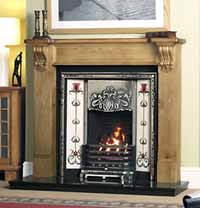
The Oxford Fireplace Insert Art Nouveau Style Fireplace
- Simple mantelpieces in more modest homes or those seeking to express humbler values, used plainer shaped brackets supporting the mantelshelf and detailing.
The Art Nouveau influence became stronger after the turn of the century, expressed in the characteristic majolica glazed tiles using “tube lining” for the sinuous designs and vibrant colours.
- Hearths were usually tiled and continued to be flush with the floor with mitred corners.
- The cast iron insert, generally square with a hood and tiled cheeks, also was used for Art Nouveau detailing.
- Emerging nationalism could be seen in the use of Australiana motifs
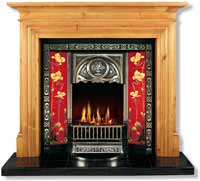
The Tulip Fireplace Insert Art Nouveau Style Fireplace
 |
| 104 Ashley St, Chatswood, NSW 2067 |
 |
| 35 Middle Harbour Road LINDFIELD |
Edwardian Style Cast Iron Fireplaces |
Edwardian Style Tiled Fireplaces |
Edwardian & Federation Tiled Inserts
- Square faced with hand painted tiles and then set behind marble or ornate timber mantles, the Edwardian & Federation register added a new level of grandeur to homes built in this ebullient period.
- Made with a cast iron fascia and decorative tiles down each side, Edwardian and Federation grates drew on design ideas from Victoriana, ‘Arts and Craft’ and the burgeoning Art Nouveau style.

Reproduction Edwardian Tube-lined Tile sets
All the great information below comes from the Website Victorian Fireplaces UK

- Tile sliders were introduced into cast iron fireplaces at side of the opening from 1860-1880. They allowed 6" tiles to be slid down at either side of the fireplace opening.
- There is no practical reason for the tiles, they are purely decorative.
- The tiles are slid into the cast iron frame, held in position by pieces of cardboard and then plastered over from the back with bonding plaster.
- Once dry the fireplace itself can be fitted. Once set into the fireplace the tile set cannot easily be changed without removing the fireplace from the wall.
Mantels and Hearths
If your fireplace has a mantel then the hearth size can vary.
- The mantel can stand on the hearth or the hearth can sit between the mantel legs or the mantel can have "cut outs".
- If you have exposed floorboards then the hearth should fully cover the constructional hearth to avoid seeing the concrete.
- If your fireplace has a mantel then the hearth size will vary depending on whether the mantel stands on the hearth or the hearth sits between the mantel legs
The Constructional Hearth
The Constructional Hearth is a flat area of fireproof material (usually concrete) in a wooden floored house that should finish flush with the floorboards around where the fire is to be fitted.The Decorative Hearth
On top of this constructional hearth sits the Decorative Hearth which is what usually refer to as a Hearth. This hearth is usually made from stone, slate or ceramic tiles.A Standard Size Hearth is 54" x 15" x2" thick
Individual Hearth Tiles are available in various finishes and shapes.
 |
| hearth |
Tiles can be cut to make herringbone patterned or cross bonded hearths
 |
| hearth |
**Quarry Tile Hearths**
Quarry Tiles are a robust unglazed tile that is hard wearing |
| hearth |
Our quarry tile hearths are available in black, terracotta and offwhite and can be made with or without a border
 |
| hearth |
Fenders
 |
| Edwardian style fender |
Arts and Crafts Fire Baskets
 |
| The Scott Fire Basket |
Arts and Crafts Firebaskets tend to be low with simple styling.
Wooden Victorian Fire Surrounds
 |
| Wooden Victorian Fire Surrounds |
The Mid Victorian period saw the introduction of the breakfront shelf and larger more elongated corbels became common on mantels.
Wooden Arts and Crafts Fire Surrounds
 |
| Wooden Arts and Crafts Fire Surrounds |
Arts and Crafts mantels with a surpisingly contemporary feel.
Wooden Art Nouveau Fire Surrounds
 |
| Wooden Art Nouveau Fire Surrounds |
Art Nouveau mantels have typical art nouveau sinuous decoration.
Wooden Edwardian Fire Surrounds
 |
| Wooden Edwardian Fire Surrounds |
In the Edwardian Era mantels became much more geometric in design. There was a return to many of the design features of the Georgian style.
Late Victorian Fireplace Inserts
 |
| Late Victorian Fireplace Inserts |
At the end of the Victorian era fireplace inserts become more square with more prominent hoods decorated with floral detail. This period saw the introduction of tiles on tile sliders.
Edwardian Fireplace Inserts
 |
| Edwardian Fireplace Inserts |
The fireplace in the Edwardian era are similar to those of the late Victorian period but even more geometric. Plain tiles became popular, matching the hearth.
For these illustrations I thank Edwardian Fireplaces UK
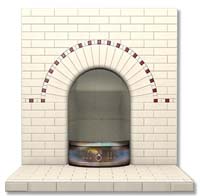 The Arts and Crafts Arch | | re017 The Arts and Crafts Arch Fireplace Insert A period recreation of a classic Edwardian tiled arched fireplace insert with Arts and Crafts detail. The insert complements a number of our Edwardian style mantles These insert designs are shown at 40"square but they can be manufactured at any size if necessary. Tiled fireplace including hearth and fret from £865 |
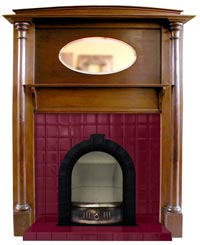 The Clarence Arch Insert Edwardian Fireplace | | re016 The Clarence Arch Fireplace Insert The Clarence Arch is also available as a fireplace insert. Most people choose to set this insert with an original mantle and it can be built to fit almost any of them. These insert designs are shown at 40"square but they can be manufactured at any size if necessary. Tiled fireplace including hearth and fret from £765 |
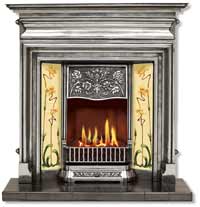
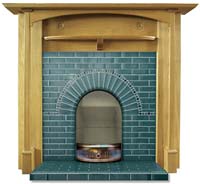
No comments:
Post a Comment